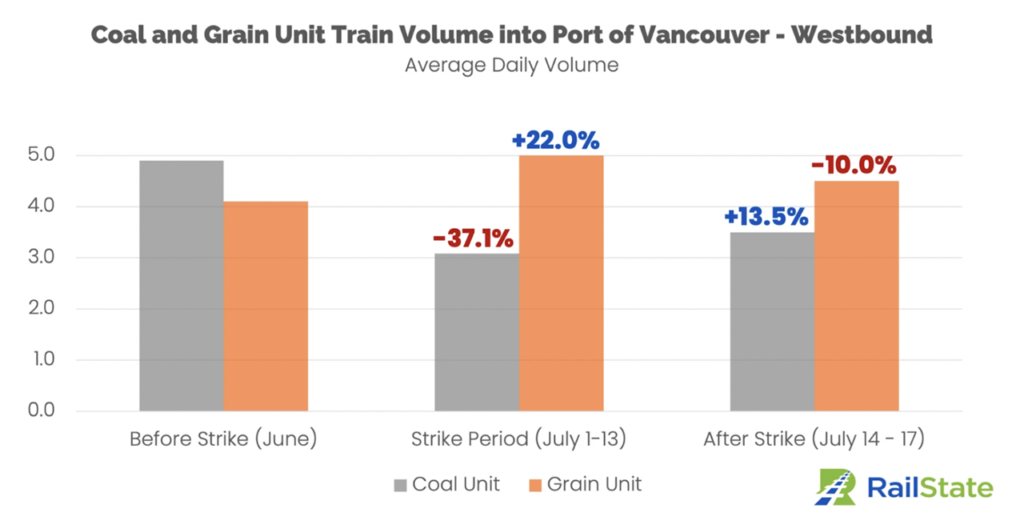
B.C. Port Strike Resumes as Union Walks Away From Tentative Deal (Updated)
Written by Nick Blenkey, Senior Editorial Consultant and Web Editor, Marine Log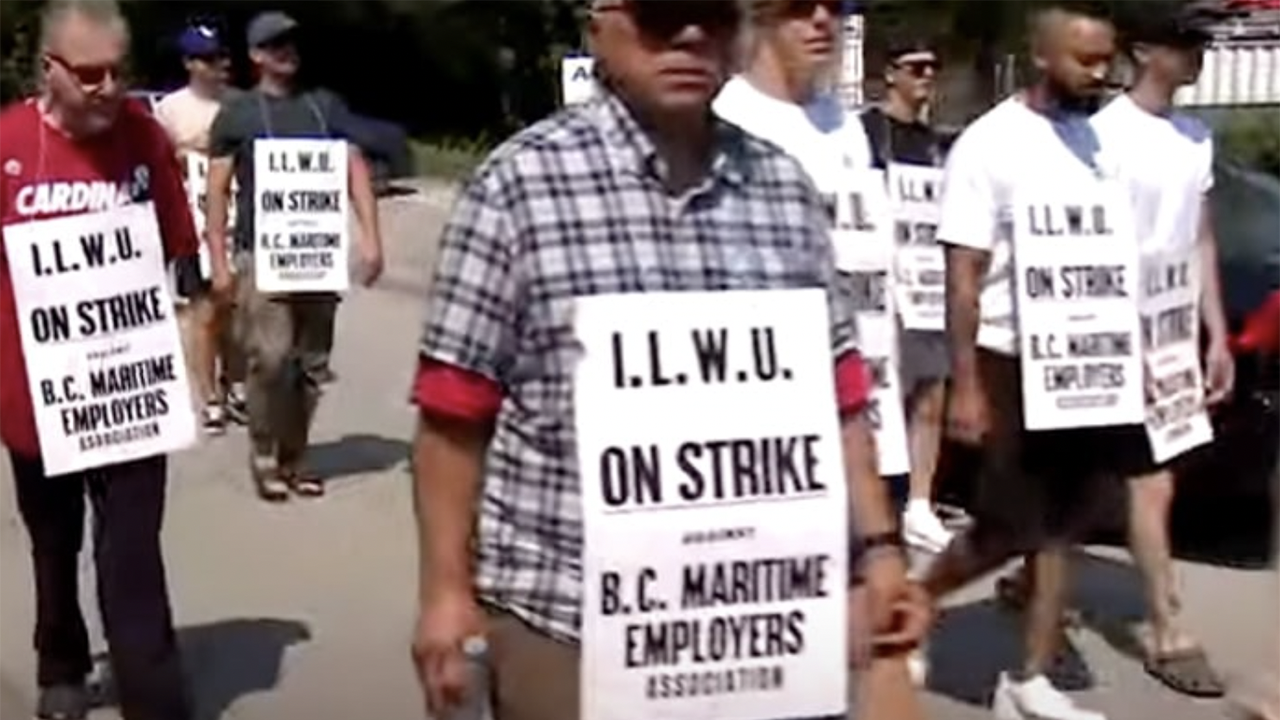
(IMAGE: Screen grab from CBC News video)
Collective bargain works, until it doesn’t. The tentative deal between the British Columbia Marine Employers Association (BCMEA) and the ILWU Canada announced July 14, didn’t last long and striking workers were back on the picket lines July 18 as Canada’s longest running port strike resumed.
On July 18, ILWU Canada, which did not submit the deal to its entire membership, said that its Longshore Caucus had rejected the deal.
“The ILWU Canada Longshore Caucus does not believe the recommendations had the ability to protect our jobs now or into the future,” said a union statement. “Our position since day one has been to protect our jurisdiction and this position has not changed.
“With the record profits that the BCMEA’s member companies have earned over the last few years the employers have not addressed the cost of living issues that our workers have faced over the last couple of years as all workers have.
“The term of the collective agreement that was given with today’s uncertain times, is far too long. We must be able to readdress the uncertainty in the world’s financial markets for our members.
“On July 18, 2023, as of 16:30 the ILWU Canada Longshore Division will be back on the picket line for a fair and negotiated collective agreement.”
What was in the tentatively agreed deal has thus far not become public.
At 8.20 a.m. PT, July 19, the BCMEA reported that the Canada Industrial Relations Board (CIRB) had convened a hearing at 9:30 p.m. on July 18 in response to the BCMEA’s application that the union had not provided 72 hours strike notice as required by the Canada Labor Code.
“The CIRB ruled that the union was in violation of the Canada Labor Code by not providing 72 hours notice, and has ordered the union to cease and desist its illegal strike action effective immediately,” said the BCMEA.
Canada’s Minister of Labor, Seamus O’Regan Jr., repeated the news of the CIRB finding in a tweet. Subsequently, he and Minister of Transport Omar Alghabra, issued the following statement:
“Last week, after 13 days of work stoppage, Minister O’Regan asked federal mediators to provide recommendations on the terms of a settlement between the BCMEA and the ILWU Canada. Both parties tentatively agreed to this settlement to bring an end to the strike.
“Today, we received formal notice from the BCMEA that their membership had accepted this deal in full. However, we were also informed that, despite initially agreeing to recommend the Terms of Settlement, the ILWU Canada’s leadership had decided not to recommend ratification of the terms to their members.
“Workers and employers across Canada cannot face further disruption on the scale we saw last week. Therefore, we are looking at all options. We will have more to say on this tomorrow.
“We should not be here. The deal presented to the parties was the result of a constructive and substantive collective bargaining process. It represented a fair and balanced deal. It was informed by weeks of collective bargaining and drafted by third-party mediators in the interest of both the union and the employer.
“We have been patient. We have respected the collective bargaining process. But we need our ports operating.”
The costs of the B.C. port strike are mounting.
“We are greatly concerned about the impacts the continuation of the strike will have on Canada’s international reputation as a reliable trade partner. In less than two weeks, business across Canada were facing shortages, temporary layoffs, and, in some cases, total shutdowns. The continuation of the strike will put these businesses at risk again,” said Greater Vancouver Board of Trade President and CEO, Bridgitte Anderson. “Unfortunately, we are beginning the process of restarting our Port Shutdown Calculator tool, which estimates a total of CAD 800 million in trade will be disrupted each day. We are renewing our call for an expedited resolution of this disruption. We need the federal government to be an active participant in finding a resolution to re-open our ports.”
RailState Rail Movement Report
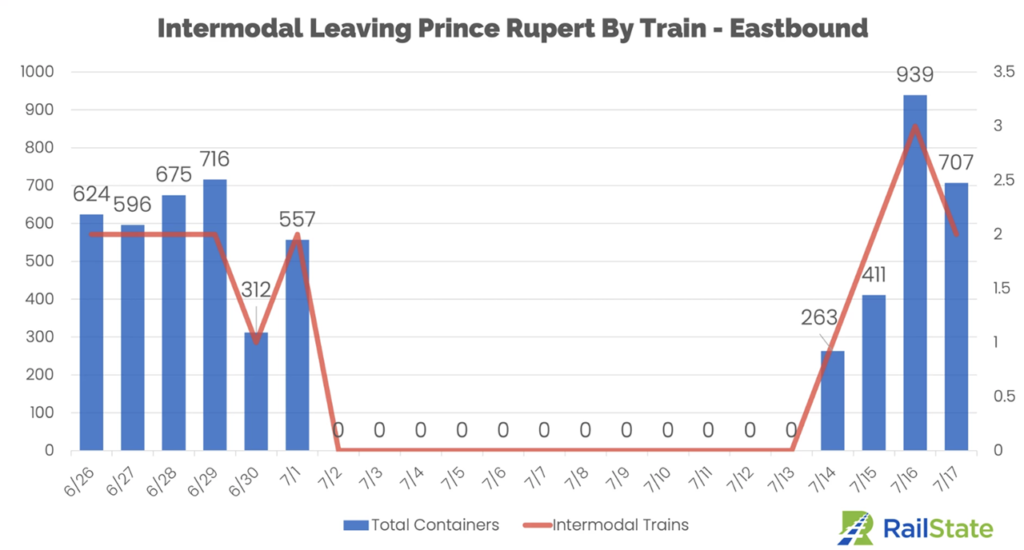
RailState on July 19 released its “Western Ports Strike Special Report–Temporary Return to Service.“ As a provider of “real-time rail network visibility,” the company said it “independently tracks all freight rail movements across Canada,“ and as such, is in “a unique position to measure rail traffic through Canada as the ports and railroads work to return to normal operations.” Following are among its findings:
“There was no intermodal import traffic from July 2 to July 13. Crews returned on July 14th and volume started moving quickly on rail.
“In the month of June, Before the strike, an average of 543 containers moved eastbound on just less than two trains per day (55 trains for the month). CN is now moving intermodal volume greater than than the average volume before the work stoppage (580 containers per day compared to 543).
“On the 14th, one intermodal train left Prince Rupert headed eastbound carrying 263 containers. On Saturday, the 15th, two trains carried 411 containers eastbound, on Sunday, July 16th, that jumped to three trains carrying 939 containers, and Monday, July 17th saw 2 trains and 707 containers moving eastbound.
“Intermodal traffic entering the port for export also increased quickly once crews returned to work at the port. There was no westbound intermodal traffic on the first day of the return to work (July 14). It makes sense that we would see eastbound traffic out of the port start before westbound traffic as teams work to unload ships that had been moored and waiting at Prince Rupert.
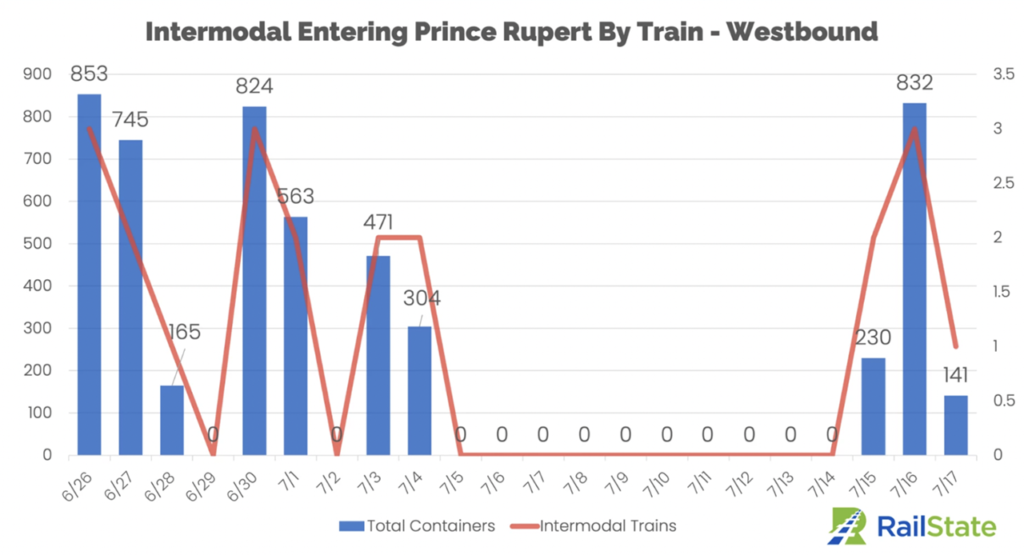
“Intermodal traffic eastbound out of the Port of Vancouver (measured at Mission City) has also rapidly returned to above average levels. Nearly 1,400 containers moved on 6 trains on July 17, which is a couple hundred containers higher than the daily average volume of 1,182 containers from before the strike.
“Note – In order to capture international containers, these numbers only include 20’ and 40’ containers moving on intermodal trains. The larger, 53’ domestic containers are excluded from the totals. Domestic intermodal continued to move during the strike.
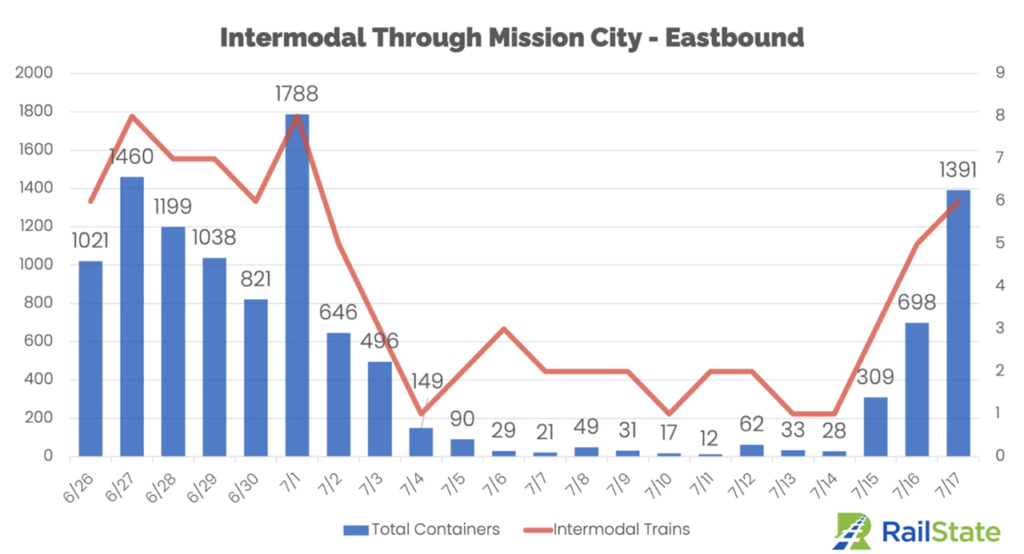
“Intermodal volume moving into the Port of Vancouver (measured at Chilliwack) has also quickly returned to levels seen before the strike.
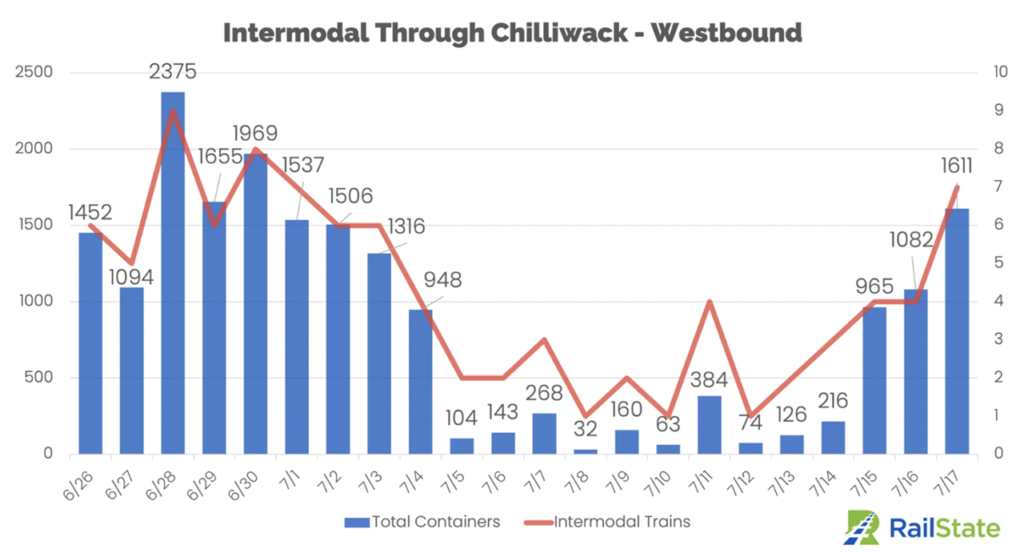
“The Port of Vancouver received 7 trains per day on average during June. Many of these trains originate in eastern Canada for a trip lasting an average of 4 to 6 days. During normal operations, there would be around 35 westbound trains underway. Instead of completing the journey to Vancouver, most of these trains were held at various points across the route and are restarting. For those that arrived into the Port of Vancouver area during the strike, the trains had to wait for unloading until the end of the work stoppage.
“There were also about 20 trains that entered the port in the few days before the start of the strike and remained in the port region, suggesting that additional capacity will be needed to resolve backlogs. The railroads have ramped up volume to clear the ports and now face another slowdown with the strike resuming.
“Not all terminals on the west coast were shut down by the work stoppage. Coal continued to move through Prince Rupert at a terminal operating under a different labor agreement than the majority of the port terminals on the west coast and did not experience a work stoppage. Coal volume for export through Prince Rupert increased 52.4% during the strike as shippers sent trains to Prince Rupert instead of the Port of Vancouver.
“Volume has started a modest decline with the end of the strike. We expect this trend to continue as shippers start sending shipments to the Port of Vancouver again.
“Similarly, grain continued to be exported. Grain is required to keep moving under Canadian law allowing grain exports to continue. Grain increased significantly, rising 77.8% in terms of average daily volume of grain unit trains. Grain has also started to show declines since the end of the strike.“
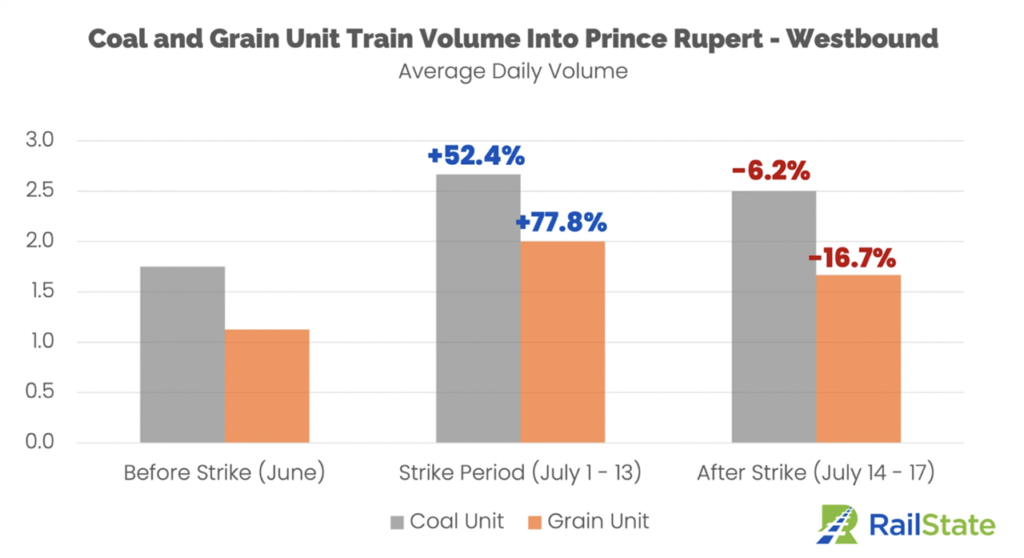
“Coal moving through the Port of Vancouver slowed significantly during the strike, dropping 37.1%. With the strike shutting down exports through Neptune Bulk Terminals in Vancouver, some shippers shifted to Prince Rupert. Westshore Terminals in Vancouver continued to operate so some coal continued to move through Vancouver. After the end of the strike, coal unit train volume is starting to increase through the Port of Vancouver.
“Grain is experiencing a different trend, having increased during the strike, it is now returning to pre-strike levels.“
